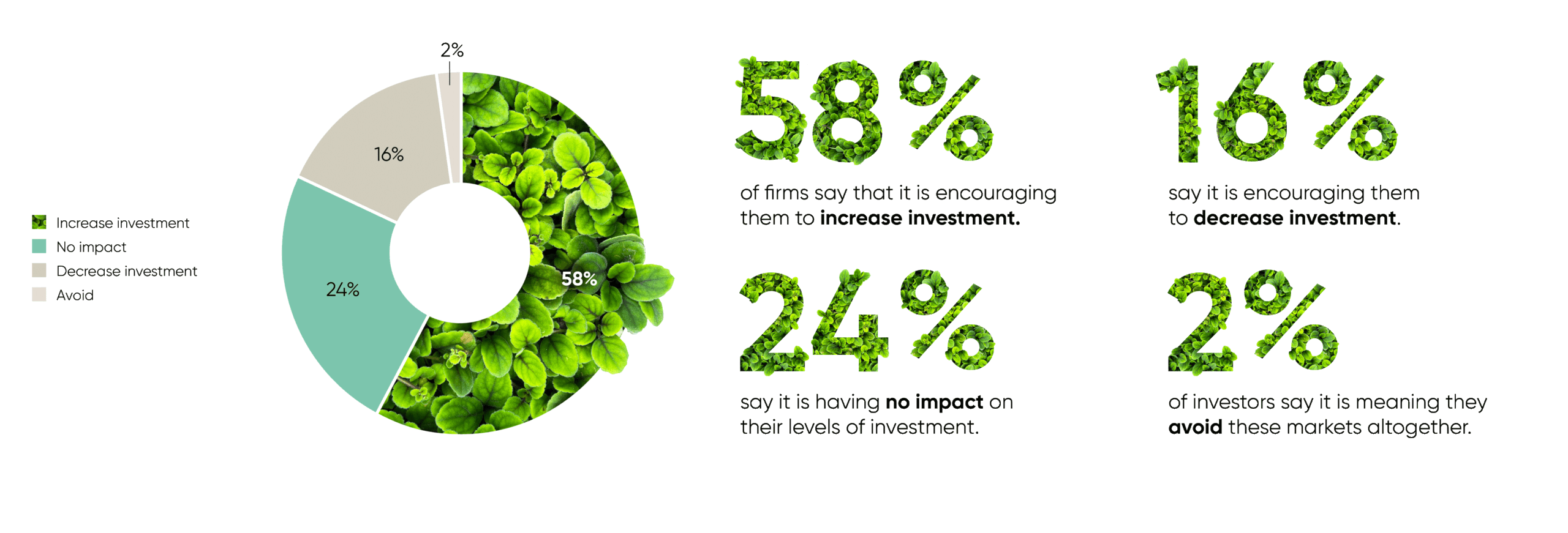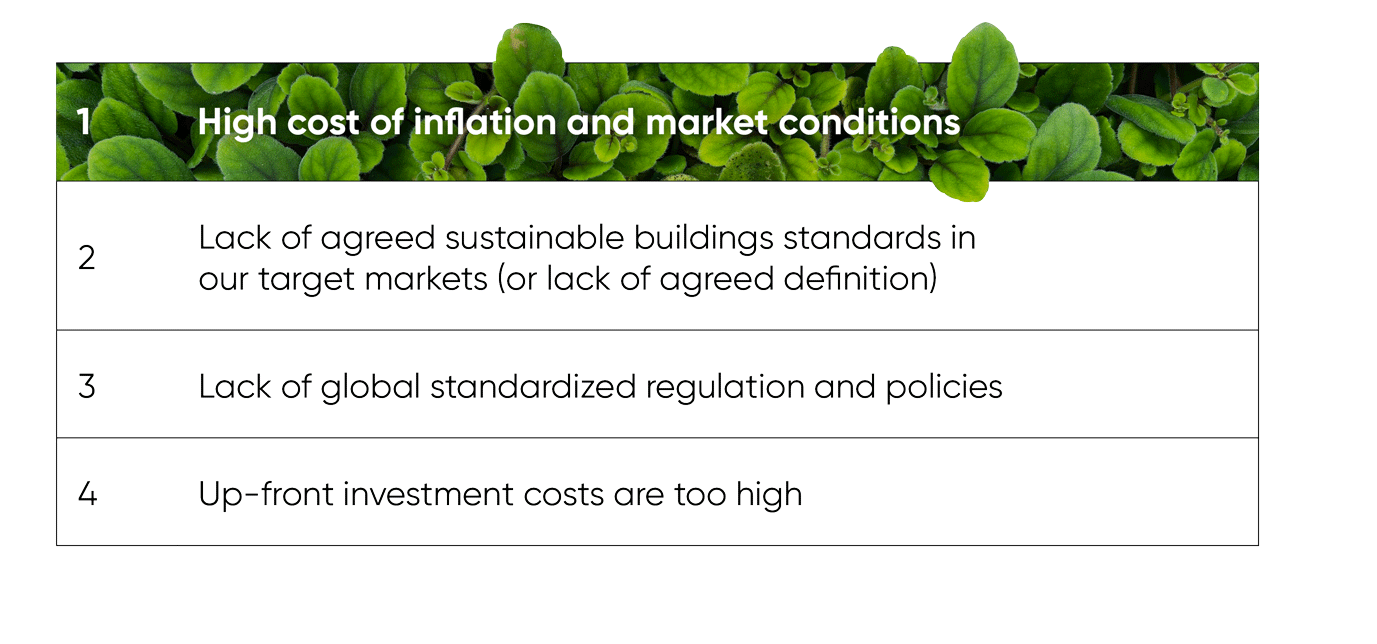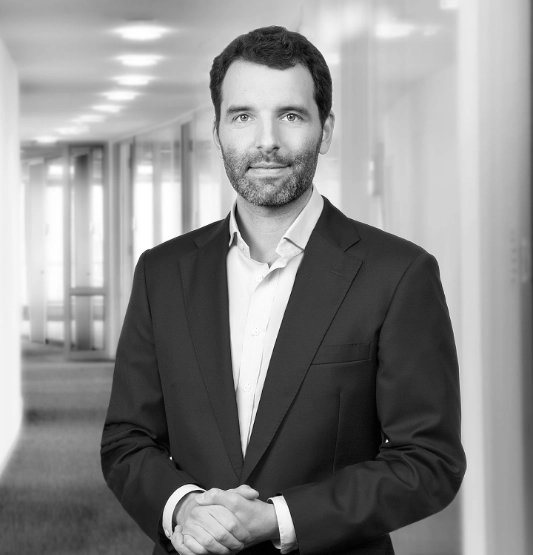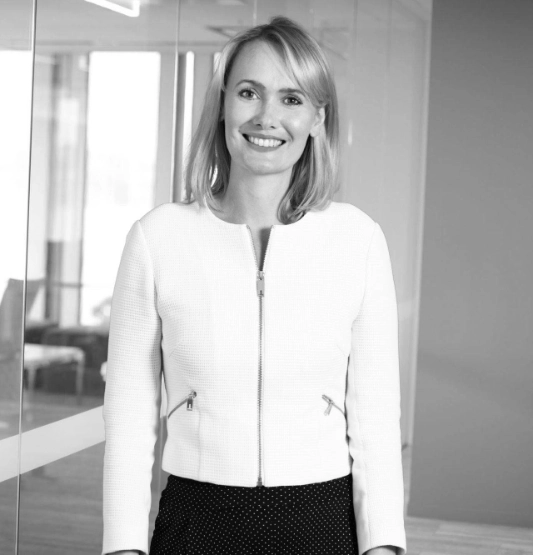Key barriers to sustainability standards
To increase the sustainability standards of commercial real estate and meet corporate demand for more sustainable rental options, our global real estate study identifies three key barriers that need to be overcome:
- a lack of consensus (including definitions, certifications and data);
- the need for cultural change and organizational transformation;
- and the difficulty in bringing older buildings up to modern sustainability standards.
The lack of consensus challenge
Three-quarters of investors in our study believe that the 'green premium' – the higher value attached to more sustainable buildings – applies mostly to buildings that meet official sustainability certifications such as LEED and BREEAM.
A recent study by property consultancy JLL found that values for London office buildings with a BREEAM certification were on average 20.6% higher than those without accreditation, and rents were on average 11.6% higher, based on a study of office investments during the five years up to December 2021.
However, one of the challenges is that there are many different accreditation and certification schemes, and there is a lack of consensus around how to define and quantify the sustainability of real estate. In fact, our study reveals that “lack of agreed sustainable buildings standards or definitions” and “lack of global standardized regulation and policies” are the most significant barriers firms face to increasing their investment in sustainable buildings, after market conditions.
Top barriers firms face to greater investment in sustainable buildings
Of the firms that said that a lack of agreed sustainable building standards in their target markets was a barrier, the US was the most frequently-cited market where this was an issue, mentioned by over a third (37%) of these investors.
This lack of standardization can make it difficult to quantify the value of sustainable real estate, and the potential return on investment in upgrading sustainability standards. More than four in five investors (81%) believe that demonstrable evidence of a green premium would increase investment into sustainable real estate.
In the EU, there is a concerted effort underway to provide a uniform taxonomy, including standards and legal frameworks.
Samant Narula, Head of Real Estate UK at BCLP
The business transformation challenge
Investors are aware that new attitudes, strategies and approaches to real estate investment will be needed to make progress against sustainability goals. Almost three-quarters of investors in our study (74%) say that it will require a “major cultural change” for their firm to put sustainable buildings at the heart of their investment strategy. The fact that only 29% of investors currently believe their leadership team is prioritizing sustainability shows how far firms have to go. There are signs that this cultural shift is already underway, with some firms creating “head of ESG” roles or similar. But is a fear of being accused of greenwashing or misclassifying funds under Article 8 and 9 regulation hindering action? Our study finds that two-thirds of investors say that ‘the risk of being accused of greenwashing’ is a barrier to progress in terms of their investment strategy for sustainable real estate.
To actually implement changes and make real estate more sustainable does not come down to investors alone – it relies on the wider ecosystem.
Emma Le Wita, Partner – Real Estate (London/Paris) at BCLP
The retrofit challenge
Almost three-quarters of corporate decision-makers (73%) say that their organization favors leasing older buildings that have been retrofitted as opposed to new builds. The top reasons for this preference are that older buildings are often in better locations (54%), their organization prefers the aesthetics of an older building (52%), and older buildings have a more positive impact on their brand (47%). This contrasts with investors’ approaches: in most markets, investors say that their primary approach is to invest in new buildings (i.e. those built in the last 10 years or currently under construction) rather than older buildings. The high cost associated with upgrading real estate is likely to be a key reason for this – 68% of institutional investors say that the cost of retrofitting buildings to reach a good sustainability standard is too high.
In fact, firms claim that a significant proportion of their real estate assets simply cannot be upgraded: on average, firms say that 22% of their real estate portfolio that fails to meet basic sustainability standards would not be possible to retrofit to higher standards and 23% would not be economically viable to retrofit. Historic city centers often have a high proportion of older buildings that would need significant retrofitting to meet current and future sustainability standards. Listings in the UK, where a structure of particular architectural or historical significance has special protection, can further complicate this.
During a time of high interest rates and steep costs, few can commit to these upgrades, and investors are increasingly crowding around the top tier of premium, modern buildings. In an effort to address this issue, the European Union implemented the Renovation Wave strategy in 2020. This initiative emphasized the potential for renovating an estimated 35 million buildings and generating up to 160,000 new green jobs within the construction sector.
Increasing sustainable real estate investment
Standardized global definitions and universal standards, paired with firmer data and evidence of the green premium, would clearly help to accelerate investment into sustainable buildings. In many jurisdictions, sustainability is still hard to measure, and the lack of standardization means that comparing the sustainability standards of one asset against another – and measuring improvement over time – can be almost impossible.
What else could spur investment? As cost is a critical barrier – especially given the expense of retrofitting older buildings to meet modern standards – government incentives could play an important role. Three-quarters of investors believe that stronger external incentives, including favorable tax treatment for sustainable property, would increase investment in sustainable real estate.
Professor Olmo Silva, Professor of Real Estate Economics and Finance at the London School of Economics and Political Science, said:
“Green loans and sustainability-linked loans are certainly important to sustainable real estate, and many of the big players are skewing their offer towards these. One of the biggest issues for developers, especially ones that want to invest in green real estate, is defraying the cost of borrowing, so any discount that you can get in order to leverage your building is important.
“The concern with this approach is that it rests on two notions that are still very hard to quantify: one is the level of discount that you're going to be giving to properties that are greener. There is a lack of understanding of how big this should be from the point of view of the reduced risk that these properties represent, and what makes a difference from the view of potential investors. There is a lack of research here and there isn’t a strong methodological approach to quantifying this reduction in risk. The other issue is that it rests on measuring KPIs that are prone to manipulation: when do you measure the emissions, when do you stop measuring them, and what is the KPI for the measurement?”
Our study also reveals that investors are generally encouraged to increase their real estate investment in markets where minimum energy performance standards for commercial buildings are being imposed or increased, rather than standards dampening investment appetite, pointing to an important role for government.
The impact of governments imposing or increasing minimum energy performance standards for commercial buildings.
Businesses agree that governments have a key role to play and argue that incentives are needed on the rental side too: 73% of corporates think there need to be stronger external incentives from government and regulators, including grants and favorable tax treatment, for renting sustainable property, rising to over 80% of businesses headquartered in the Middle East and Asia.

Fons van Dorst, Executive Managing Director UK at real estate developer EDGE, believes that the real estate industry needs to go further than simply meeting environmental and sustainability thresholds:
It is critical to think beyond basic real estate sustainability standards and consider both the environmental and social impacts of commercial real estate. It’s not just about having a sustainable building, but about having a responsible building. An inclusive building. This means a building that is aware of its surroundings: that is accessible and welcoming to a diverse range of people, and that fosters a relationship with the local community. We design buildings to be open and inviting, and to facilitate a link between the occupiers and the community; incorporating spaces that enable those who work inside and those who live nearby to meet each other.
BCLP in practice - Green Financing
Our sustainable lending team, spanning the UK, US, Europe and Asia, advises on green finance products and green real estate financing.
There are two main types of green finance products in the real estate market: green loans and sustainability-linked loans, and the main difference between the two is how the proceeds of the loan are used. Generally, the proceeds of a sustainability-linked loan will seek to improve the borrower’s overall sustainability profile by linking certain loan terms to the borrower’s performance against a set of predetermined KPIs. Proceeds of green loans are usually applied to a project or endeavor that is categorized as green or social, and, in some instances, a loan may be structured to allow for it to be both a green loan and a sustainability-linked loan.
We have advised on a range of diverse projects, from high profile investment financings of landmark buildings and development financings of award-winning construction projects, to loans for charging points on the River Thames, and private forest carbon investments.
We work with the main industry bodies across the globe (APLMA - Asia Pacific Loan Market Association, LMA - Loan Market Association, and LSTA - Loan Syndications and Trading Association) to develop and prepare green, sustainable and social loan principles, as well as advise on their related guidance notes.
BCLP in practice - PropTech
Property Technology (PropTech) is a fast-emerging segment of the technology sector. Our technology and real estate lawyers collaborate to address the evolving innovations and help bring technology solutions to the real estate clients. Traditional PropTech involved the combination of real estate and technology in segments like data centers and technology enabled services within an estate, such as estate-wide Wi-Fi arrangements. Emerging PropTech is disrupting much wider segments of the real estate sector, including property financing through P2P and crowd-funded websites, alternative leasing structures that landlords have created for their mixed-use TMT assets and the technology that enables the internet of things, smart buildings and smart cities.
These developments are increasing the importance of technology for all stakeholders in the real estate sector, from investors, landlords, developers, managing agents through to tenants. Clearly, there is an increasing use of artificial intelligence and machine learning for automated tasks in the real estate industry. At BCLP, we are a global thought leader in the AI space, with skills in specialized AI governance, regulatory and commercial experience in the development and implementation of AI solutions. We frequently present on AI-related topics, including numerous presentations on the risks, challenges, ethical considerations, and regulatory frameworks emerging around AI. We have developed an AI Regulation Tracker, which is designed to update readers on legislation in the U.S., UK and Europe, helping our clients stay informed in this rapidly changing regulatory landscape.
We are at the forefront of developments in the sector, actively exploring ways in which this emerging technology can support our clients. We recently partnered with Orbital Witness, an award-winning PropTech and LegalTech startup, on a transatlantic generative AI project to optimize commercial lease reporting. A global design partnership will test, optimize and deploy Orbital Witness’ lease reporting capabilities in its latest generative AI solution, Orbital Copilot, across BCLP’s U.K. and U.S. real estate practices.
Orbital Copilot is the first real estate-sector-specific AI assistant created for real estate lawyers that can analyze and report on any real estate document. By leveraging Orbital Witness’ market-leading capabilities in real estate-specific AI and the deep sector knowledge and experience of BCLP’s global real estate practice, this first-in-market collaboration seeks to use this cutting-edge technology to enhance BLCP’s reporting on complex commercial leases, providing accelerated insights to their clients. Through a series of workshops and user experience sessions, BCLP lawyers in the U.K. and U.S. will work with Orbital Witness to test Orbital Copilot across different transaction types and jurisdictions to push this technology to the next level.
















